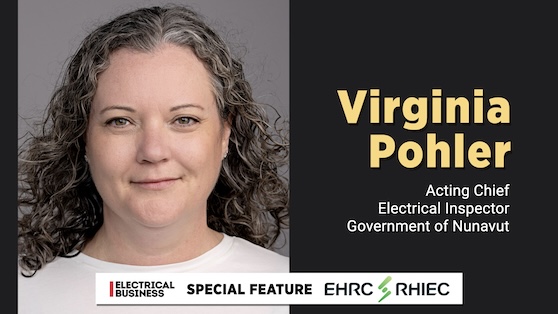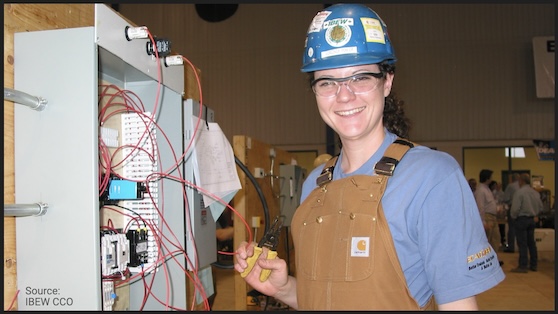
Articles
Features
Women in Power
Articles
News
Profiles
Women in Construction
Women IN power – Virginia Pohler, Government of Nunavut
March 22, 2024 | By Anthony Capkun
Willing to step back so as to leap forward
 Source: Supplied
Source: Supplied March 21, 2024 – Before I sit down to profile a female electrical professional, I send them a list of standard “get-to-know-you” questions to get the conversation going.
Questions like: “Describe the moment you decided to get into Electrical, and/or the decisions that led up to it” and “What were some of the barriers you faced that were unique to you as a woman?”.
From their responses and follow-up interviews, I write the profiles you’re about to read. I eagerly await those responses—and to having those conversations—because everyone’s career journey is unique unto itself.
THIS IS VIRGINIA POHLER’s STORY
Like a tree, Virginia’s career path in Electrical involved many branches. Numerous achievements led to setting new goals until, eventually, she landed in her current role as Acting Chief Electrical Inspector with the Government of Nunavut, Dept. of Community & Government Services.
“My career came to me in stages,” Virginia recalls, who always had an interest in technical subjects and math. While in high school, she had thought about pursuing Engineering but, while selecting her Grade 11 courses (which again included Shop), Virginia started thinking about a career as an electrician—to which her guidance counsellor promptly said: “You’re too smart for that. Go to university”.
When post-secondary education came calling, however, “it was apparent I couldn’t afford to go to university”.
Not knowing what to do next, Virginia found herself in a boring, dead-end factory job, doing the same thing 800 times a day on rotating shift. “I moved into an apartment, and devoted more time to drinking and partying than I’d like to admit,” she grins.
But work at the factory slowed down, to the point where Virginia was out of a job. Thankfully, she qualified for up to 52 weeks of government-assisted job retraining.
“I knew this was a big opportunity, and I didn’t want to waste it,” she says. “I researched the labour market, and all indicators pointed to in-demand jobs in skilled trades and healthcare. At the factory, I was always interested in whatever the maintenance crew was doing, so I enrolled in an industrial electronics technician diploma program at Fanshawe College in January 2001.”
Toward the end of her program, Virginia had two job offers: robotics technician or construction apprenticeship. She chose the latter.
“But I don’t want anyone to think that getting this entry-level position was easy!” Virginia says. “I sent out over 800 resumes and got only three interviews and two job offers.” (At one of the three interviews, the owner said he would not hire Virginia because she would be “a distraction to the guys on the job”.)
Since she first entered the Electrical industry as a college student and apprentice, Virginia has amassed a number of career accomplishments.

Virginia competes in the 2006 Ontario Skills Competition. She wins Bronze for her electrical installation work.
“I have earned Certificates of Qualification as a 309A Construction & Maintenance Electrician and 442A Industrial Electrician,” she says proudly. “I am also a Master Electrician, Certified Canadian Electrical Inspector, and Certified Fire & Explosion Investigator—in addition to my college diploma as an Industrial Electronics Technician.”
In all of these pursuits, Virginia graduated at or near the top of her class. She was the valedictorian of her inspector training program earning, and won Bronze at the Ontario Skills Competition 2006 for her installation work.
Over the course of her career, she has worked for both unionized and non-union organizations in the construction, industrial, safety, training, and regulatory fields.
“There’s a lot to like about the electrical industry,” Virginia advises. “In general, the work is not repetitive; even boring jobs like plugging and switching a building, or digging a trench didn’t bother me. I knew that that portion of the job would only last until the last device was installed or the last shovel scooped—then it was on to something else, or another building.”
Even when times were slow, Virginia found a way to make the most of the situation.
“I’ve always been able to generate income, as there are so many branches within the industry to challenge me. In fact, the slow times are what propelled me forward; I took a step back financially, sure, but I leaped forward professionally.”
Recently, Virginia set a goal to have a “a seat at the table”—that is, a Voting Seat on the Technical Committee for the Canadian Electrical Code–Part I. At the end of last year, she achieved that goal.
“I now find myself mid-life and mid-career, trying to figure out what the next big goal is going to be,” Virginia says, enthusiastically. “If someone had asked me at the very beginning of my career journey where I thought I would be in 2024, I never would have thought I would accomplish even half the things I’ve done.”
Virginia’s recipe for success involves working under some great mentors and managers. But perhaps the most important factor behind her career achievements has been agility.
“I think the biggest determining factor in my career success has been a willingness to go to the next door when I realized the first door was closing; to take a step back financially to get the experience needed for future gains, coupled with an overall resilience to the negatives of working in this industry.”
Sadly, and shamefully, Virginia has experienced a lot of negatives along her career path.

Virginia (right) heading out for a 5-minute walk to work with her then-trainee inspector, Nadine, in -55ºC.
“Aside from blatantly discriminatory hiring practices, the level of sexual harassment I have faced is appalling,” she says. “I’ve been groped, grabbed, cornered, and propositioned more times than I can count. I’ve faced a death threat, a gang rape threat, and have been told I’m taking work away from men who need to feed their families.”
She’s lost count as to the number of times she has been asked whether she really is an electrician. Once she confirms she is, in fact, a qualified professional, “I usually get a patronizing ‘Oh, good for you’ comment which, to me, is like nails on a chalkboard!”
Meantime, Virginia is ecstatic about her current role as Acting Chief Electrical Inspector in Nunavut.
“I now work in the most gender, religious, and culturally diverse workplace I have ever experienced, and it has brought me more personal fulfilment and satisfaction than anywhere else,” she beams.
Quoting Statistics Canada, Virginia says that women made up less than 2% of the workforce when she started in the industry. Almost 25 years later, that percentage has climbed to just 4.5%.
“That should be a sign that our efforts are not working and we need to shift gears,” she says. It’s not that women are uninterested or incapable of working in the industry, Virginia says. Far from! Instead, she feels managers need more training on how to lead gender and culturally diverse teams.

Virginia’s office in Cambridge Bay, Nunavut. There are currently four members on the Electrical Inspection team—half of which are women.
“The men who have helped me succeed in this industry are the ones who had the exact same performance expectations of me as they did for every other worker; that dealt with bad actors swiftly and decisively; and who hired or promoted me based on my skills, qualifications, and experience—knowing full well they will likely have to continue dealing with workplace harassment and discrimination.”
“If these types of managers were the norm, I believe at least a tenth of the workforce would be female by now,” Virginia says. “If we truly want women to succeed and excel in this industry, we must have workplace cultures that support them.”
This is an excerpt from “Meet these Women in Power” (February 2024 ed.), a SPECIAL FEATURE brought to you by Electrical Business Magazine in partnership with Electricity Human Resources Canada.
Taking on an apprentice may be simple, but it is by no means easy, so hire smarter with work-integrated learning (WIL) opportunities, wage subsidies, and financial incentives for students and apprentices through EHRC.
You’ll find all Back Issues of Electrical Business Magazine in our Digital Archive.
Print this page
